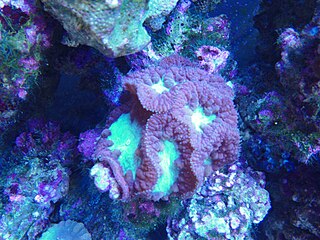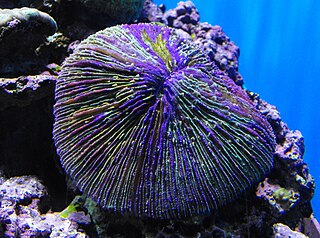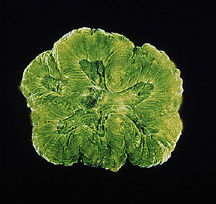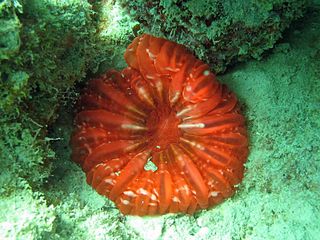
The Fungiidae are a family of Cnidaria, commonly known as mushroom corals or plate corals. The family contains thirteen extant genera. They range from solitary corals to colonial species. Some genera such as Cycloseris and Fungia are solitary organisms, Polyphyllia consists of a single organism with multiple mouths, and Ctenactis and Herpolitha might be considered as solitary organisms with multiple mouths or a colony of individuals, each with its separate mouth.

Acanthastrea is a genus of large polyp stony corals in the family Lobophylliidae. The colonies are massive and usually flat. The corallites are either circular or angular in shape. The septa are thick near the wall of the corallite, becoming thin near the columella, and have tall teeth. The polyps are extended only at night.

Favia is a genus of reef-building stony corals in the family Mussidae. Members of the genus are massive or thickly encrusting colonial corals, either dome-shaped or flat, and a few are foliaceous. There is a great diversity of form even among individuals of the same species. The corallites project slightly above the surface of the coral and each has its own wall. In most species, the corallites are plocoid and in some, monocentric. The septa and costae linked to the corallite wall are well developed and covered by fine teeth. The polyps only extend and feed during the night. Each one has a small number of tapering tentacles which often have a darker coloured tip; these are called stinger tentacles, or sweeper tentacles. They use these to sweep the water to see if any other coral is in its area; if so, then they begin to sting the other coral. This is commonly known as coral war. Each coral is trying to make sure it has enough room around it so it can continue to grow and have more surface area for its offspring. The columella is parietal and spongy, and there are vesicles on both the endotheca and exotheca. Members of this genus are widespread in both the Atlantic Ocean and the Indo-Pacific.

Blastomussa is a genus of large polyp stony corals. It is unclear in which family this genus belongs. Members of this genus are sometimes found in reef aquariums.

Fungia is a genus of corals in the family Fungiidae. It is monotypic with the single species Fungia fungites, which is found growing on reefs in the Indo-Pacific.

Cycloseris is a genus of solitary disc corals in the family Fungiidae. They are found in the Indo-Pacific. They inhabit the lower reef slopes, and the areas between reefs with soft sediments. They tolerate turbid waters.

Meandrina is a genus of colonial stony coral in the family Meandrinidae. Corals in this genus form massive hemispherical heads or have large flat plates and can grow to a metre (yard) across. Sometimes it is referred to as.

Oulophyllia is a genus of stony corals in the family Merulinidae. Members of this genus are native to the tropical western and central Indo-Pacific region.

Dasmosmilia is a genus of small corals in the family Caryophylliidae.
Acropora rudis is a species of acroporid coral found in the Indo-Pacific region. It is an uncommon species and is classified by the International Union for Conservation of Nature as an endangered species because it is particularly susceptible to coral bleaching, coral diseases, damage by the crown-of-thorns starfish and destruction of its coral reef habitat.

Isophyllia is a genus of stony coral in the subfamily Mussinae of the family Mussidae.

Pleuractis is a genus of mushroom corals in the family Fungiidae. Members of the genus are found growing on reefs in the Indo-Pacific.
Homophyllia is a genus of stony corals in the family Lobophylliidae.

Cynarina is a genus of stony corals in the family Lobophylliidae.

Rhombopsammia is a genus of stony corals in the family Micrabaciidae commonly known as button corals.

Paragoniastrea is a genus of stony corals in the family Merulinidae.

Manicina is a genus of reef-building stony corals in the family Mussidae.

Heterocyathus is a genus of coral of the family Caryophylliidae.

Heteropsammia is a genus of apozooxanthellate corals that belong to the family Dendrophylliidae.

Pectinia is a genus of corals belonging to the family Merulinidae.



















